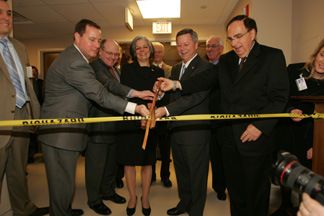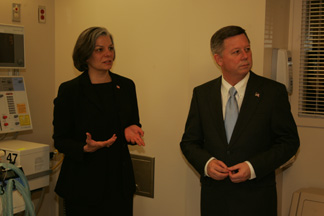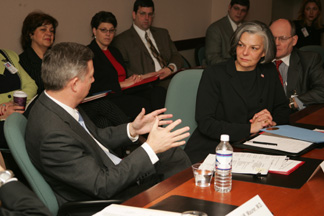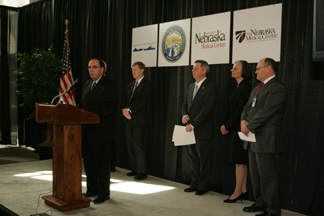 |
Julie Gerberding, M.D., participates in Monday’s ribbon-cutting ceremony for the new Biocontainment Unit at The Nebraska Medical Center. Photo by Tim Fitzgerald. |
“Nebraska is leading the way (in bioterrorism preparedness) and the biocontainment unit is one stellar example of that kind of preparedness,” Dr. Gerberding said.
The 10-bed unit, set up to handle highly contagious and deadly infectious conditions, is the first-of-its-kind in the nation. “We do not have any other capacity like this in the nation,” Dr. Gerberding said. “Part of the beauty of this particular facility is that it would serve not only for Nebraska, but for the other states that are engaged in the Midwest alliance and who create the agreements.”
There are only two other biocontainment patient care units in the country. The U.S. Army Medical Research Institute of Infectious Diseases houses a two-bed special Bio-safety patient care suite at Ft. Detrick, Md., for military members and investigators who may be exposed to infectious agents, and the CDC has a two-bed unit at Emory University Hospital in Atlanta.
 |
Julie Gerberding, M.D., and Nebraska Gov. Dave Heineman tour the 10-bed Biocontainment Unit. Photo by Tim Fitzgerald. |
Nebraska’s success, she said, has evolved from established priorities, “phenomenal” performance and the leadership, vision and passion of state leaders to execute the job, referring to the “extraordinary leadership” of Richard Raymond, M.D., chief medical officer for Nebraska Health and Human Services System (HHSS); Nebraska Gov. Dave Heineman; Philip Smith, M.D., director of the Nebraska Center for Biopreparedness Education and director of the Biocontainment Unit; UNMC Chancellor Harold M. Maurer, M.D.; and Glenn Fosdick, president and chief executive officer of The Nebraska Medical Center.
“We’re really excited about the unveiling of the new biocontainment unit,” Dr. Maurer said. “We’re delighted with this new addition to the Medical Center.”
“When patients are hospitalized with these diseases, they’re quite dangerous to care for,” Dr. Smith said. “We now have the kind of unit that can provide care that protects the staff that take care of them, that protects other patients in the hospital and protects our community.”
 |
Julie Gerberding, M.D., and Nebraska Gov. Dave Heineman discuss the collaboration that took place in developing the biocontainment unit. Photo by Tim Fitzgerald. |
The funding comes from federal bioterrorism dollars allocated to Nebraska, along with contributions from The Nebraska Medical Center and UNMC.
“This unit gives testimony to what can happen through collaboration,” Fosdick said. “A hospital alone cannot do what we’ve done here. A state medical school or health department alone cannot do what we have done. It takes all of us working together with our eyes on the future and our focus on preparedness.”
Dr. Gerberding praised the “health protection heroes” who volunteered and trained to work in the new biocontainment unit, which creates the “safest possible environment.”
 |
UNMC Chancellor Harold M. Maurer, M.D., opens the press conference featuring CDC Director Julie Gerberding, M.D. Photo by Tim Fitzgerald. |
“Nebraska is better equipped today to respond to bioterrorism events than ever before,” Gov. Heineman said. “This unit represents a win-win situation. In better preparing for homeland defense we are being better prepared for other emergencies from tornados to infectious diseases introduced naturally or by a terrorist.”
“Since 2002, the four campuses of the University of Nebraska have worked together on terrorism research through a Center for Biosecurity administered by the University of Nebraska Medial Center,” Gov. Heineman said. “UNMC has earned praise over and over again for its caliber of research. It leads the way in developing technology to detect and react to a biological attack. State government’s unique collaboration with UNMC and other partners makes very, very good sense.”